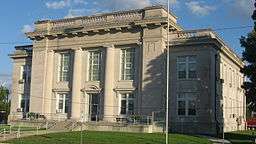Louisville, Illinois
| Louisville, Illinois | |
| Village | |
 The Clay County Courthouse on the public square | |
| Country | United States |
|---|---|
| State | Illinois |
| County | Clay |
| Coordinates | 38°46′17″N 88°30′23″W / 38.77139°N 88.50639°WCoordinates: 38°46′17″N 88°30′23″W / 38.77139°N 88.50639°W |
| Area | 0.75 sq mi (2 km2) |
| - land | 0.75 sq mi (2 km2) |
| - water | 0.00 sq mi (0 km2) |
| Population | 1,139 (2010) |
| Density | 1,518.7/sq mi (586/km2) |
| Timezone | CST (UTC−6) |
| - summer (DST) | CDT (UTC−5) |
| Postal code | 62858 |
| Area code | 618 |
  Location of Louisville within Illinois | |
| Wikimedia Commons: Louisville, Illinois | |
| Website: villageoflouisvilleil | |
| Although spelled the same as Louisville, Kentucky, the general pronunciation of the town is "Lewis-ville". | |
Louisville is a village in Clay County, Illinois, United States, along the Little Wabash River. The population was 1,139 at the 2010 census.[1] It is the county seat of Clay County.[2]
History
The village was named for the Lewis family of settlers.[3]
Geography
Louisville is located near the center of Clay County at 38°46′17″N 88°30′23″W / 38.77139°N 88.50639°W (38.771356, -88.506301).[4] U.S. Route 45 passes through the village, leading north 25 miles (40 km) to Effingham and south 8 miles (13 km) to Flora.
According to the 2010 census, Louisville has a total area of 0.75 square miles (1.94 km2), all land.[5] The Little Wabash River flows past the east side of the village.
Demographics
| Historical population | |||
|---|---|---|---|
| Census | Pop. | %± | |
| 1860 | 313 | — | |
| 1870 | 529 | 69.0% | |
| 1880 | 514 | −2.8% | |
| 1890 | 637 | 23.9% | |
| 1900 | 646 | 1.4% | |
| 1910 | 670 | 3.7% | |
| 1920 | 797 | 19.0% | |
| 1930 | 803 | 0.8% | |
| 1940 | 925 | 15.2% | |
| 1950 | 970 | 4.9% | |
| 1960 | 906 | −6.6% | |
| 1970 | 1,020 | 12.6% | |
| 1980 | 1,166 | 14.3% | |
| 1990 | 1,098 | −5.8% | |
| 2000 | 1,242 | 13.1% | |
| 2010 | 1,139 | −8.3% | |
| Est. 2015 | 1,116 | [6] | −2.0% |
As of the census[8] of 2000, there were 1,242 people, 503 households, and 311 families residing in the village. The population density was 1,794.1 people per square mile (695.0/km²). There were 543 housing units at an average density of 784.4 per square mile (303.8/km²). The racial makeup of the village was 99.28% White, 0.16% African American, 0.16% Native American, 0.08% Asian, 0.24% from other races, and 0.08% from two or more races. Hispanic or Latino of any race were 0.40% of the population.
There were 503 households out of which 28.4% had children under the age of 18 living with them, 48.7% were married couples living together, 9.7% had a female householder with no husband present, and 38.0% were non-families. 34.4% of all households were made up of individuals and 20.1% had someone living alone who was 65 years of age or older. The average household size was 2.31 and the average family size was 2.97.
In the village the age distribution of the population shows 23.7% under the age of 18, 8.5% from 18 to 24, 24.5% from 25 to 44, 21.9% from 45 to 64, and 21.4% who were 65 years of age or older. The median age was 39 years. For every 100 females there were 92.3 males. For every 100 females age 18 and over, there were 84.8 males.
The median income for a household in the village was $25,250, and the median income for a family was $35,673. Males had a median income of $27,083 versus $21,719 for females. The per capita income for the village was $13,119. About 13.1% of families and 18.9% of the population were below the poverty line, including 19.7% of those under age 18 and 15.6% of those age 65 or over.
History - Grand Army of the Republic
The G.A.R. had a post known as the Louisville Post, No. 249 with the post name of William J. Stephenson. The post received its charter May 18, 1883.
Notable people
- Tom Richardson, pinch hitter for the St. Louis Browns; born in Louisville
- John Riley Tanner, governor of Illinois January 11, 1897 – January 14, 1901; home and farm in Louisville
References
- ↑ "Geographic Identifiers: 2010 Demographic Profile Data (G001): Louisville village, Illinois". U.S. Census Bureau, American Factfinder. Retrieved August 1, 2014.
- ↑ "Find a County". National Association of Counties. Retrieved 2011-06-07.
- ↑ Gannett, Henry (1905). The Origin of Certain Place Names in the United States. U.S. Government Printing Office. p. 191.
- ↑ "US Gazetteer files: 2010, 2000, and 1990". United States Census Bureau. 2011-02-12. Retrieved 2011-04-23.
- ↑ "G001 – Geographic Identifiers – 2010 Census Summary File 1". United States Census Bureau. Retrieved 2015-08-04.
- ↑ "Annual Estimates of the Resident Population for Incorporated Places: April 1, 2010 to July 1, 2015". Retrieved July 2, 2016.
- ↑ "Census of Population and Housing". Census.gov. Retrieved June 4, 2015.
- ↑ "American FactFinder". United States Census Bureau. Retrieved 2008-01-31.